The Gueiquesale (pronounced guey-kay-sally) were one of the large native groups
whose territory included the southern portion of the Plateaus and
Canyonlands. They are one of the many, lesser-known native peoples
who were a casualty of the calamitous changes during the Historic
period. In that sense, their story represents the fate of many native
groups who once roamed Texas: extinction and near oblivion.
Although the Gueiquesale actually may have occupied or ranged over
a much larger region, they are not discussed in Spanish documents
with any depth until the 1670s, when they began to solicit the help
and protection of the Spanish. By that time, the Apache were pushing
south off the Southern Plains due to Comanche intrusion into their
former homeland. In their wake, many native groups were also pushed
southward. Gueiquesale territory at that time was centered on the
general vicinity of modern Del Rio and north into the Canyonlands
as well as south into Coahuila.
Although much of the Plateaus and Canyonlands had not been explored
by the Spanish prior to the 1670s, word of unrest of various native
peoples in the general region had reached northern Mexican towns
in the 1660s. Some reports indicated that as early as 1658 native
peoples from north of the Rio Grande were asking the Spanish for
missions and presidios and actually petitioned the government to
settle close to Saltillo. The petition was denied, but it and other
requests prompted Father Juan Larios, a Franciscan friar, to travel
north toward the Rio Grande where he stayed for three years.
Upon his return, natives were again petitioning for settlement.
This time the petition included a number of groups (Babane, Jumano,
Bobole, Baia, Contotore, Tetecore, and Momone). The petition also
asserted that these groups would be joined by two other very large
groups: the Gueiquesale and the Tiltic y Maigunm.
One Gueiquesale was brought before the court. He testified that his
people wished to settle in pueblos (towns).
The motives of the petitioners are important in understanding subsequent
events. The smaller of these native groups said they needed to band
together with larger groups. Another factor was that several years
past some native peoples had aided the Spanish in battles against
the Cacaxtles and others. Likely, they were concerned about reprisals
from the Cacaxtles or allies of the groups that had been attacked.
They were equally concerned about the continuing Spanish raiding
of their rancherías for slaves. Although Spain’s official
policy outlawed slave raids, unofficially they continued. The native
people in the Plateaus and Canyonlands practiced a hunting and gathering
lifestyle, requiring them to move frequently from place to place.
Their small, temporary encampments (rancherías) left them
vulnerable to the raids. Living among larger groups would make them
less vulnerable, particularly if the settlements contained missions
and presidios.
Permission was given in early 1674 for the larger settlements to
be established in northern Coahuila. Priests, including Fray Larios
and Dionysio de Penasco along with Fray Manuel de la Cruz, and soldiers
under the command of Captain Elisondo, traveled north to northern
Coahuila where they founded two settlements. Santa Rosa de Santa
Maria was located on the Sabinas River. San Ildefonso de la Paz was
14 leagues (36 miles) north of the Sabinas and about 50 miles south
of Del Rio. Gueiquesale were the largest group at San Ildefonso,
numbering over 500, but other Gueiquesale were also among the natives
at Santa Rosa. These settlements were the first of several in this
general area, all aimed at bringing natives of northern Coahuila
and the Plateaus and Canyonlands south to live in settlements, learn
to farm, and become peaceful communities. Their successes and failures
over the next several years illustrate the reality was less than
desired.
Traveling north of the Rio Grande, the friars persuaded many groups
to go south and settle with them in the two settlements. As many
as 3,200 natives were reported living in clusters near Santa Rosa
in June of 1674. However, their presence had as much to do with the
large prickly pear fields that were also near Santa Rosa. Reports
from the friars state that the natives were eating the ripe prickly
pear tunas, but they also reported concern that the natives would
leave when the harvest was over. Their fears were well grounded.
Having no stores of food in the settlement, the natives and priests
left Santa Rosa to find other food. In their absence, natives destroyed
the settlement that same summer.
Other settlements and missions were established over the next century,
some ending like Santa Rosa, others having limited success. As late
as 1762, 26 Coetzales (Gueiquesale) were living at San Miguel de
Aguayo of Monclova. While the efforts of priests and soldiers to
establish settlements for the Gueiquesale and other groups did not
meet with the successes they hoped, they left behind a number of
Spanish documents with details about the Gueiquesale and their allies,
the foods they sought, as well as some details about their family
and spiritual lives. Those details are summarized below.
Alliances with other Native Peoples
Like other native peoples, the Gueiquesale had alliances with other
groups. Spanish documents are far from perfect in telling us about
those alliances, but the repeated presence of the Gueiquesale with
certain other groups (and not with certain other native peoples)
strongly suggest their friendship with them. Hence, we suspect that
they were close to the Manos Prietas, Babane, Jumano, Bobole, Baia,
Contotore, Tetecore, and Momone because these groups included the
Gueiquesale as among the peoples who wanted to establish settlements
in northern Coahuila.
In several documents from the 1670s, Don Esteban, a Gueiquesale
leader, appears to have been the leader of a coalition of people
who included the Gueiquesale, Manos Prietas, and no less than 22
other native groups. Leaders like Don Esteban were charismatic individuals
who tended to make decisions that enhanced the well being of the
larger group. When such a leader emerged, other, often smaller groups,
sought friendship with the leader’s group. During stressful
times, such allies could be called upon to come to their aid. Certainly,
the large numbers of groups under Don Esteban’s leadership
together with the Gueiquesale population estimates of more than 700
must have made his a fairly powerful and well-respected coalition.
Alliances among groups were not static. Like similar arrangements
among countries today, they shifted as situations changed. Reports
about Spanish efforts to settle the Gueiquesale document that another
group—the Yorica—sought an alliance with the Gueiquesale.
The manner in which this alliance was sought—cautiously through
an intermediary and with gifts—may represent the way alliances
were formed among different people in the Plateaus and Canyonlands.
In 1674, one of the priests pressed north of the Rio Grande to encourage
the Manos Prietas to move south. The Manos Prietas were already likely
allies of the Gueiquesale.
Earlier that year, Captain Elisando met with leaders of groups who
wanted to settle, and the Gueiquesale and Manos Prietas were among
those leaders. When Fray Penasco found the Manos Prietas in the Plateaus
and Canyonlands, they told him of another group, the Giorica or Yorica,
who lived just to the north. Here, the Manos Prietas acted as intermediary.
It is interesting that the Yorica first approached the priest rather
than the numerous Gueiquesale who, at that time, were enjoying the
prickly pear tuna fields near the Sabinas River. Perhaps this was
simply because the priest was there and interested in meeting new
peoples he could encourage to move into the settlements. On the other
hand, it may reflect the caution of the Yorica, a way to illicit
information about other groups yet still be able to retreat if necessary.
Regardless, Fray Penasco sent ambassadors to the Yorica. During
the ensuing diplomatic exchanges, they released to the Manos Prietas
a captive Gueiquesale boy. This was the gift. The
Yorica likely knew of the alliance between the Manos Prietas and
the Gueiquesale, and were told during the diplomatic exchanges the
Manos Prietas were going to travel south with the priest. Giving
up the captive boy was an offering of good will. The offering was
accepted and sealed by a ceremony to celebrate the boy’s return.
In the end, 300 Yorica traveled with the Manos Prietas to Santa Rosa
where they were peacefully settled among the other residents, including
the populous Gueiquesale.
Gueiquesale Life and Families
According to records written by the priests, the Gueiquesale subsisted on mescal,
tunas of prickly pears, acorns and other nuts, fish, deer and buffalo.
At one point the friars were out of food and ate the same sotol,
lechuguilla, and tule reeds as the natives.
When the Gueiquesale and their allies lived in the settlements,
they did learn to farm, successfully raising a few crops. However,
the settlements did not have the resources to sustain large numbers
of people indefinitely nor year round. Because of this, the people
would return to the settlements when crops were ready for harvesting,
then travel north to the Plateaus and Canyonlands to hunt deer and
buffalo or other resources during the rest of the year.
Spanish documents inconsistently report on the family lives of
native peoples. Each author reported on things that seemed important
to him. Thus, we glean information from small bits and pieces. For
peoples like the Apache, seen over a broad territory and a long time,
the small bits and pieces eventually add up to a bigger picture.
Not the whole picture, but certainly a better one. For the Gueiquesale,
the picture remains small, but it is tantalizing.
We know that the Gueiquesale were relatively numerous. Persons
pleading for native missions near the Rio Grande specifically say
that the Gueiquesale are one of two much larger groups. We learn
from another document that the settlements near the Rio Grande had
512 Gueiquesale there. Another document states that over 700 Gueiquesale
were in a camp north of the Rio Grande. Given their hunting and gathering
lifestyle, it is doubtful that all Gueiquesale families would move
en mass. The Chihuahuan desert in which they resided was limited
in resources and would have made such large camps difficult to feed.
On the other hand, when the priests traveled with them in 1674,
their reports suggest that smaller groups traveled parallel to one
another, separated by several leagues. Such a pattern would have
allowed them to keep in touch while finding sufficient food to feed
the people who traveled in the individual group. Each group moved
when local food resources were depleted. Seasons of plenty would
likely have encouraged many of these smaller groups to come together.
Such seasons would have been when prickly pear tunas ripened in some
of the areas where it grew in abundance and when the Gueiquesale
cooperated to hunt bison. In addition to providing sustenance, these
large group gatherings would have renewed friendships and other ties
that bound the Gueiquesale together as a unified whole.
We know that they cared for one another. When the Spanish tried
to settle the Gueiquesale into one of the Coahuila settlements in
1674, they declined because their people were ill and they wanted
to take them away to care for them. They promised to return when
the sick ones were better. The men showed great valor in battle.
When one of the priests, Fray Manuel, was concerned for his life
while he was north of the Rio Grande, Gueiquesale warriors came to
his aid, embracing him. Their scouts found the enemy group nearby,
and the Gueiquesale warriors declared to the priest they would die
before they would abandon him. Together, these actions suggest a
loyal, close-knit people.
Changing Worlds
The world of the Gueiquesale and other native groups in the Plateaus
and Canyonlands underwent drastic changes beginning in the 1600s.
We know that the Gueiquesale and their allies wanted the protection
and aid of priests and soldiers. While they clearly did not understand
the Catholic or other European religions, they did witness firsthand
native groups in Saltillo and other Spanish communities, finding some
measure of protection after ascribing to a belief in the European
religion. We also know that these groups were under increasing pressure
from the Apache advance south into their territories. Strange new
diseases, such as smallpox and measles, entered their territory at
the same time as these Europeans and those diseases killed their
friends and families.
We cannot fully understand how the Gueiquesale interpreted these
changes. But, we do know that several rock art panels in Val Verde
County show mission-like architecture. One has a stick-like European
figure in front of such a structure with his hands raised. Given
that it is generally believed that rock art represents expressions
of a group’s spiritual life, could these represent an effort
to reach out to this new religion of a people unaffected by the Apache
intrusion or the diseases? We may never know for certain, but these
rock art panels are few and unique.
Another aspect of spiritual life and tradition is provided in the
description of their battle with other groups. As described above,
when Fray Manual feared for his life, 98 Gueiquesale warriors led
by Don Esteban went to his rescue. Apart from their bows and arrows,
hide-covered shields, and a small loincloth of deerskin, they also
wore body decoration—streaks of red, yellow, and white across
their chests and arms. In addition, they wore headdresses made of
vines, mesquite leaves, and feathers.
Since we know that none of these body adornments would be used as
weapons, we must assume that either they were ways to ensure that
in a battle one could easily tell who was an ally and who was an
enemy, or they were ways to ward off death. Before the battle, the
priest showed the warriors a cross, or image of Christ, and told
them that God would help them overcome the superior numbers of enemies
they faced. When this same priest was taken to their ranchería,
a village of some 700 people, the Gueiquesale women danced to express
their pleasure at his visit. Apparently, this was their custom when
visitors they wanted to see came to their villages.
|
The Gueiquesale were also known as Coetzale, Gueiquesal,
Gueiquechali, Guericochal, Guisole, Huisocal, Huyquetzal, Huicasique,
Quetzal, Quesale, among other names.
|

The Rio Grande River near its juncture with the Pecos River. The area, near present-day
Del Rio, was the center of Gueiquesale territory in the 1670s, extending north
into the Canyonlands and south into Coahuila The towering cliff on the right
marks the mouth of the Pecos River canyon. Photo from ANRA-NPS archives at
TARL. |
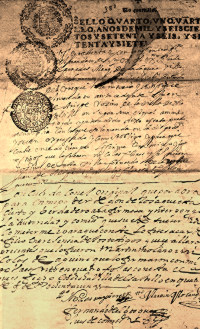
Diary of Fernando del Bosque, who traveled into the interior of Texas with Father Juan Larios in 1677 to investigate unrest among native peoples. Photo courtesy of the Center for American History (Documents for the Early History of Coahuila and Texas: 2Q259-836, Vol.4, p.380). |
The native people in the Plateaus and Canyonlands practiced
a hunting and gathering lifestyle, requiring them to move frequently
from place to place. Their small, temporary encampments ( rancherías)
left them vulnerable to raids by the Spanish, who sought slaves
in spite of bans on such practices, and attacks by other native
groups. Living among larger groups would make them less vulnerable,
particularly if the settlements contained missions and presidios. |
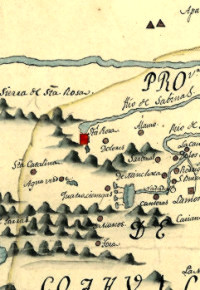
Settlements established by Spanish priests in northern Coahuila (Mexico) in the mid-1600s. Native peoples, including the Gueiquesale, sought protection by banding together into larger groups in "pueblos," or small towns such as Santa Rosa, shown with red dot. Click to enlarge. |
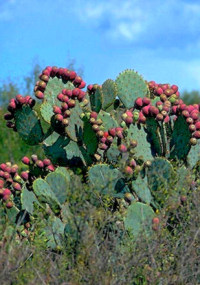
Ripening of fruits (tunas) of prickly pear cactus annually beckoned native peoples out of missions and settlements and into the fields for harvesting and celebrations. Photo courtesy Texas Parks and Wildlife Deaprtment. |
As many as 3,200 natives were reported living in clusters
near Santa Rosa ( Mexico) in June of 1674. However, their presence
had as much to do with the large prickly pear fields that were
also near Santa Rosa. Reports from the friars state that the
natives were eating the ripe prickly pear tunas, but they also
reported concern that the natives would leave when the harvest
was over. |
Cattails or tule reeds were used by native peoples both as a nutritious food source and as thatch for their shelters. One account of a Gueiquesale encampment |
At one point the friars were out of food and ate the same
sotol, lechuguilla, and tule reeds as the natives. |
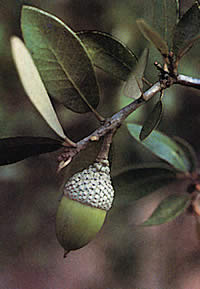
Acorns, one of the many nuts and fruits harvested by native peoples on the Edwards Plateau. |
Seasons of plenty would likely have encouraged many of
these smaller groups to come together. Such seasons would have
been when prickly pear tunas ripened in some of the areas where
it grew in abundance and when the Gueiquesale cooperated to
hunt bison. In addition to providing sustenance, these large
group gatherings would have renewed friendships and other ties
that bound the Gueiquesale together as a unified whole. |

Desert lands in southwest Texas, with typical scrubby growth of lechuguilla and other arid-adapted plants. Native peoples, such as the Gueiquesale, were able to subsist in harsh conditions by moving frequently to other areas as fruits and nuts ripened and by roasting the hearts, or bases, of plants such as lechuguilla, sotol. |
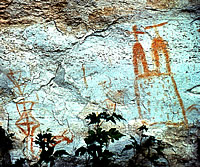
An orange-red church and a lone rider in European garb, the work of an unknown historic-period native artist, loom from the shelter wall in a Lower Pecos canyon. Perhaps native peoples painted these and similar images as a means of recording events and to help make sense of a rapidly changing world. Photo from site 41VV343, TARL archives. |
|